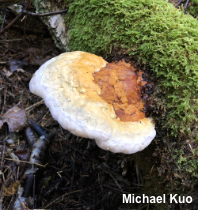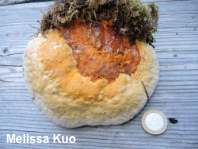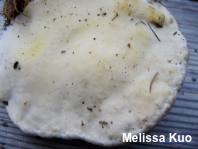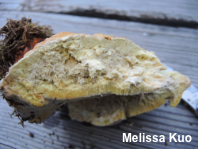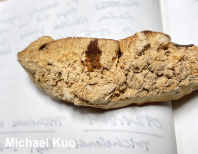| Major Groups > Polypores > Fomitopsis pinicola |

|
Fomitopsis pinicola [ Basidiomycota > Polyporales > Fomitopsidaceae > Fomitopsis . . . ] by Michael Kuo This common Eurasian polypore appears on the wood of conifers and hardwoods, and features a shiny orange-red to red band, shellacked in appearance, on its cap surface, along with a thick, whitish marginal zone. Since this fungus is perennial, developing a new pore surface each year, older specimens become hoof-shaped, with crusty brown to nearly black zones toward the point of attachment. The flesh is pale (creamy to slightly yellowish or faintly brownish) and unchanging when sliced, but a drop of KOH produces a red to reddish brown color change. Varnished-looking, red species of Ganoderma can appear superficially similar, but feature brownish flesh that turns black with KOH, as well as very different microscopic features. Older specimens of Fomitopsis pinicola can appear similar to Fomes fomentarius, but the latter lacks red shades and has a brown pore surface and flesh. North American versions of Fomitopsis pinicola include Fomitopsis ochracea, Fomitopsis schrenkii, and Fomitopsis mounceae; see the latter page for help sorting them out. Many North American sources combine Fomitopsis schrenkii and Fomitopsis mounceae as "Fomitopsis pinicola," but studies of DNA and morphology by Haight and collaborators (2016, 2019) determined that Fomitopsis pinicola is strictly Eurasian. Description: Ecology: Saprobic on the deadwood of conifers and hardwoods; also sometimes parasitic on living trees; causing a brown cubical rot; growing alone or gregariously; perennial; originally described from Sweden; widespread in Europe and Asia. The illustrated and described collection is from France. Cap: Up to about 25 cm across and 15 cm deep; semicircular or fan-shaped in outline; convex or hoof-shaped; becoming wrinkled; with orange to red, varnished zones of color toward the margin (and overall when young); red to dark brownish red, brown, or nearly black toward the point of attachment when mature; with a fairly thick white to pale yellowish marginal zone; varnished areas bubbling and melting with flame. Pore Surface: Whitish to slightly yellowish; not bruising significantly; with 3–4 round pores per mm; annual tube layers usually fairly distinct, up to 8 mm deep. Stem: Absent. Flesh: Whitish to slightly yellowish or brownish; leathery to woody. Odor: Strong and fragrant or sour when fresh. Chemical Reactions: KOH on flesh red to brownish red. Microscopic Features: Spores 6–9 x 3–4.5 µm; subellipsoid; smooth; hyaline in KOH; inamyloid. Basidia 4-sterigmate. Cystidia not found. Hyphal system trimitic, with clamped, thin-walled generative hyphae, thick-walled skeletal hyphae, and branching, thick-walled binding hyphae. REFERENCES: (O. Swartz, 1810) P. Karsten, 1881. (Fries, 1821; Phillips, 1980; Breitenbach & Kränzlin, 1986; Buczacki et al., 2013; Haight et al., 2016; Gminder & Böhning, 2017; Haight et al., 2019; Læssøe & Petersen, 2019; Kibby, 2020.) Herb. Kuo 09241808. This site contains no information about the edibility or toxicity of mushrooms. |
© MushroomExpert.Com |
|
Cite this page as: Kuo, M. (2022, June). Fomitopsis pinicola. Retrieved from the MushroomExpert.Com Web site: http://www.mushroomexpert.com/fomitopsis_pinicola.html |
